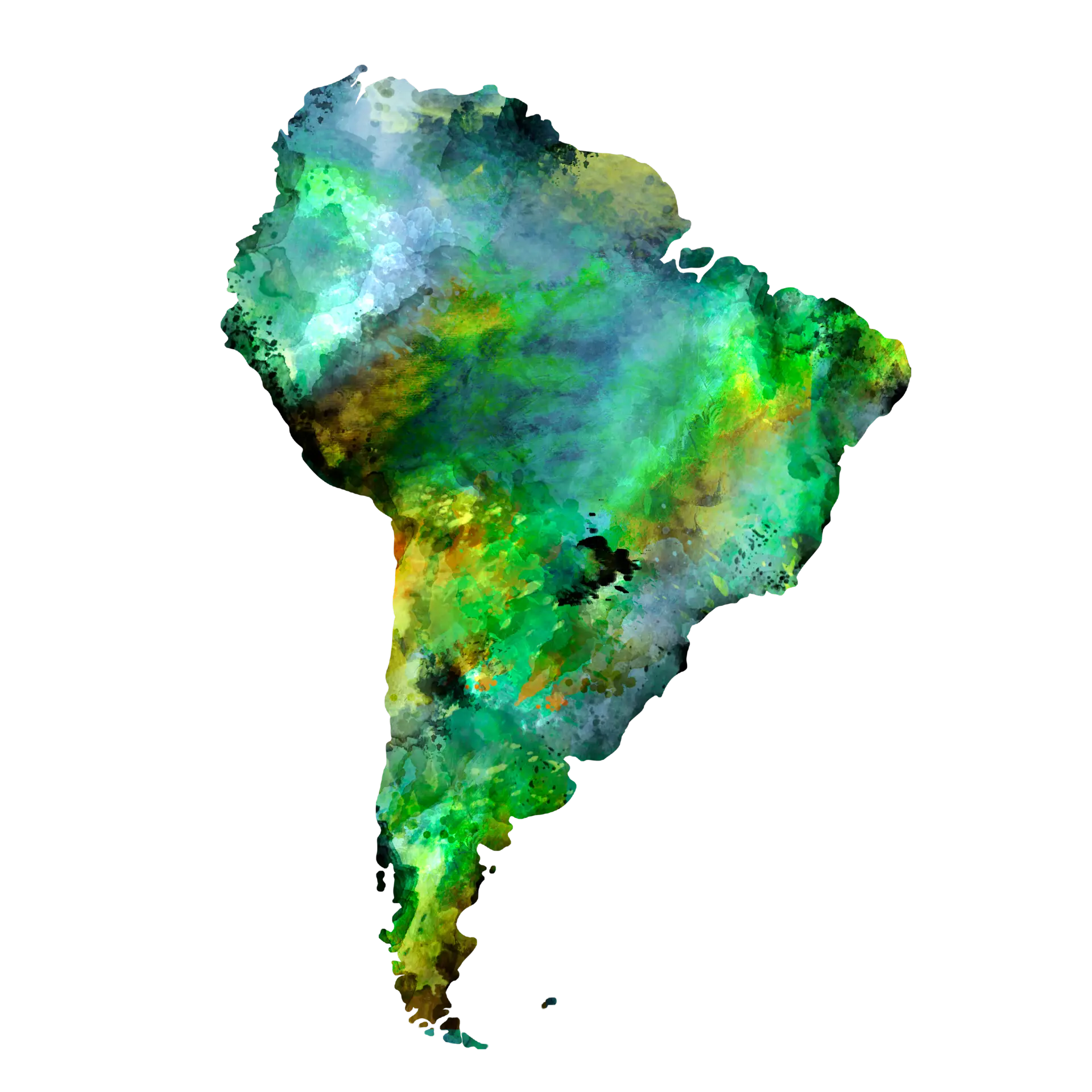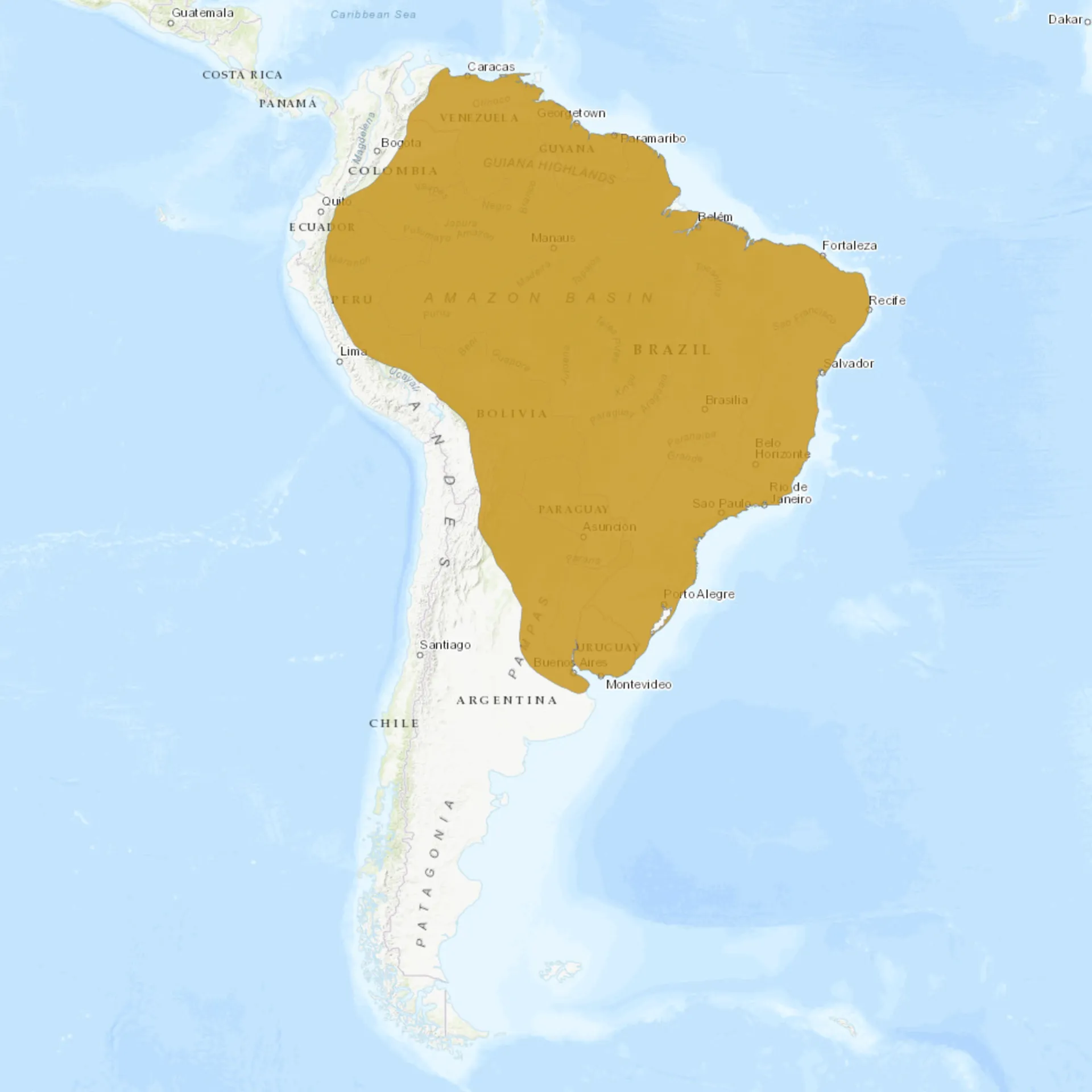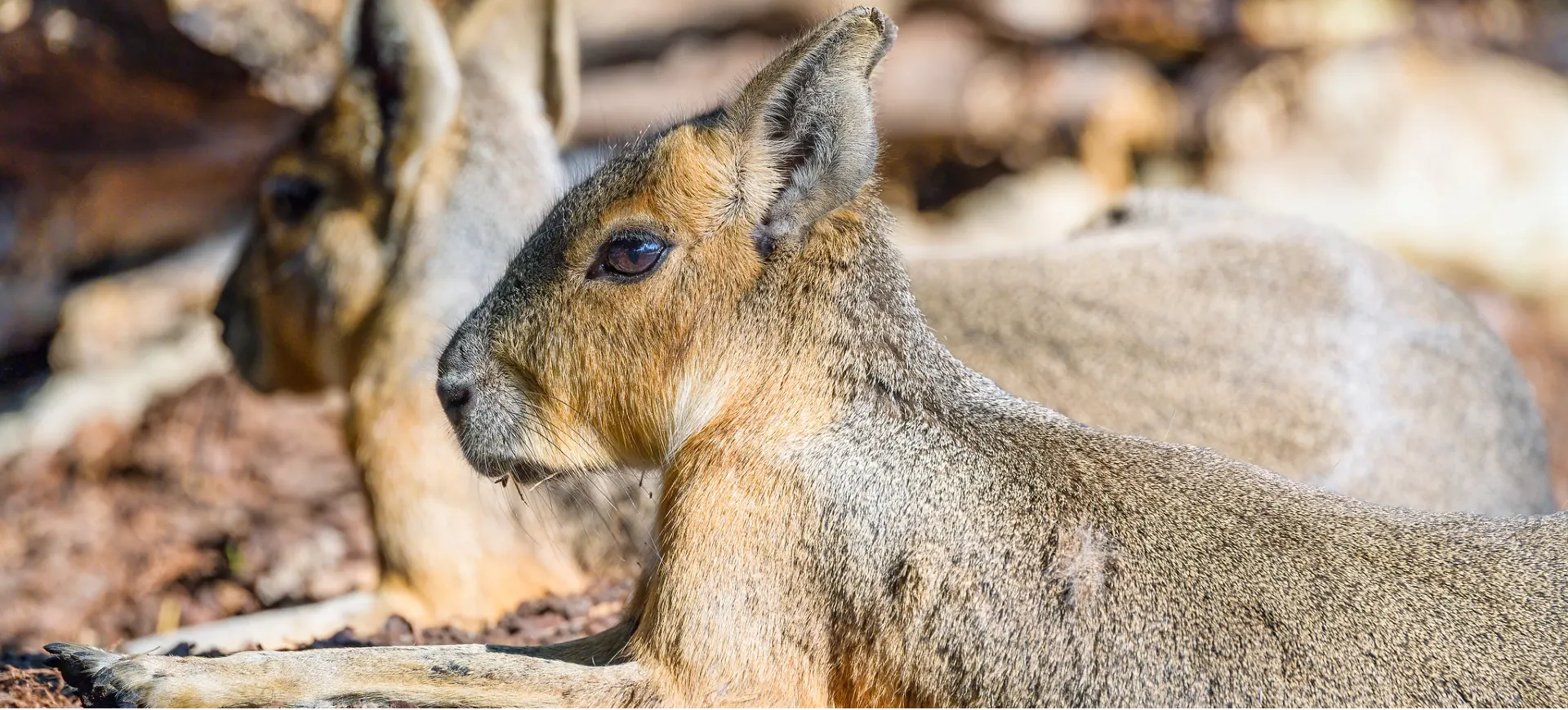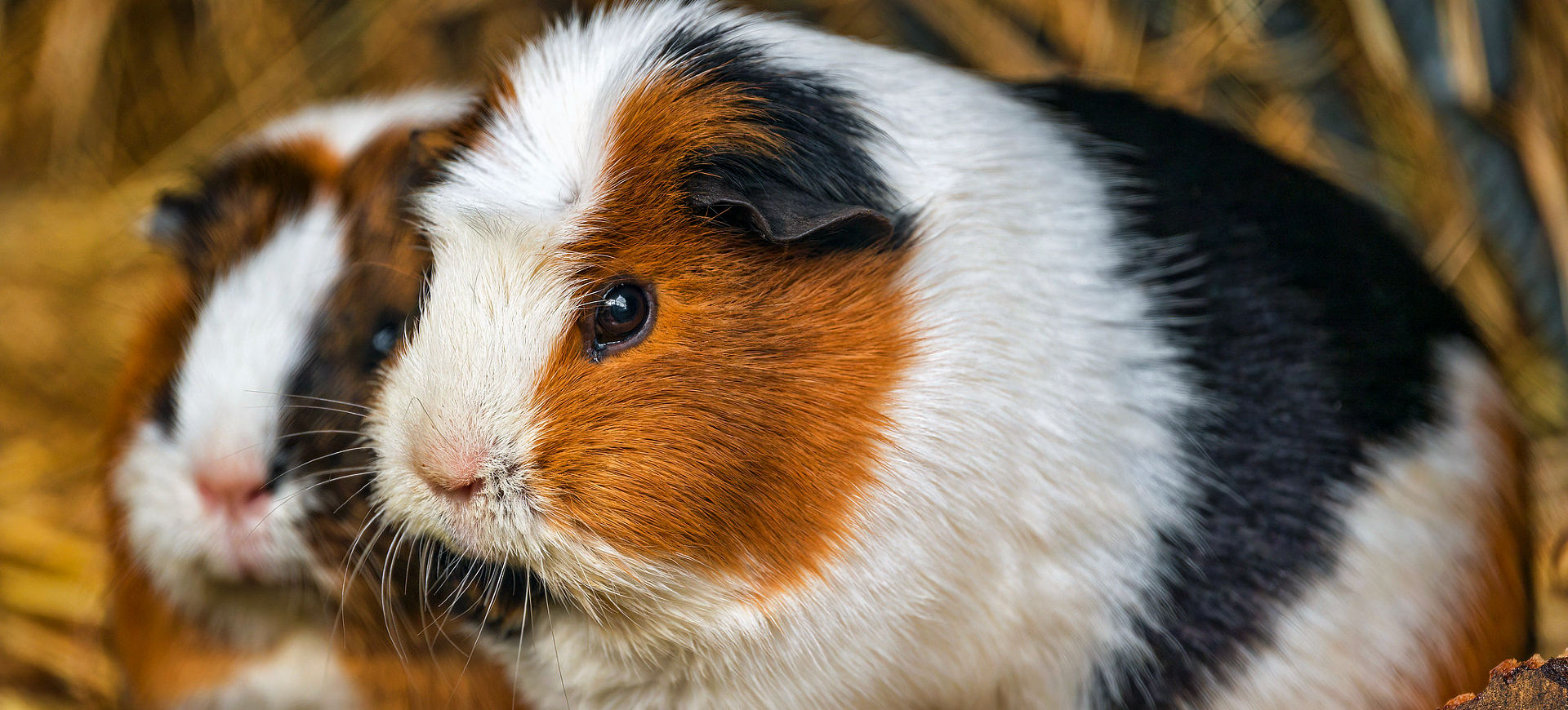Overview
The capybara (Hydrochoerus hydrochaeris) is the largest living rodent in the world and is native to South America. It is a highly social, semi-aquatic species found in wetlands, riverbanks, and forested areas, where it thrives in groups. Capybaras have a stocky, barrel-shaped body with short limbs, webbed feet, and a blunt snout, making them excellent swimmers. They are known for their calm and friendly nature, often coexisting peacefully with various other animal species, including birds and predators.
These herbivorous mammals primarily feed on grasses, aquatic plants, and fruits, which is vital in shaping their wetland ecosystems. Their continuously growing incisors help them graze efficiently, and they also engage in coprophagy (eating their feces) to maximize nutrient absorption. Capybaras depend highly on water sources for thermoregulation, hydration, and protection from predators. They are most active during dawn and dusk, exhibiting crepuscular behavior to avoid the day’s heat.
Capybaras have a complex social structure, typically in groups of 10–20 individuals led by a dominant male. They communicate through vocalizations such as whistles, barks, and purrs, which help maintain group cohesion and alert others to danger. Although they are hunted for meat and hide in some regions, their populations remain stable due to their adaptability and high reproductive rate. They are currently classified as Least Concern by the IUCN, but habitat destruction and illegal hunting pose localized threats.
Taxonomy
Kingdom
Phylum
Class
Order
Family
Genus
Species
Type
Current distribution:
Capybaras are widely distributed across South America, from Colombia and Venezuela in the north to Argentina and Uruguay in the south. They are especially abundant in the wetlands of the Amazon Basin, the Pantanal, and the Orinoco River floodplains. Their range overlaps with several key conservation areas, helping to ensure stable population numbers. Despite their adaptability, they are absent from high-altitude regions and dense rainforests where water sources are inaccessible.
Although their population is stable, localized declines have been observed due to hunting and habitat destruction. In some regions, they are hunted for their meat and hide, leading to population pressures. However, they have successfully adapted to living near human settlements, where they sometimes graze on crops and become a nuisance to farmers. Conservation efforts focus on protecting wetland habitats and regulating hunting to maintain sustainable capybara populations.
Physical Description:
Capybaras have a robust, cylindrical body covered in coarse, brownish fur that helps them blend into their environment. Their head is large and blunt with small ears, a broad nose, and forward-facing eyes, all positioned high on the skull to aid in semi-aquatic life. They have short but strong legs with webbed feet, making them excellent swimmers capable of staying submerged for several minutes to evade predators. Their incisors grow continuously, requiring constant grazing to maintain proper length and function.
Despite their large size, capybaras are agile on both land and water, capable of quick bursts of speed when escaping threats. Their sparse fur dries quickly, helping them regulate body temperature in warm environments. Unlike many other rodents, capybaras lack a long, visible tail, further contributing to their unique appearance. Their thick, barrel-shaped body helps retain heat, making them well adapted to tropical and temperate climates.

Lifespan: Wild: ~8 Years || Captivity: ~12 Years

Weight: Male: 77–146 lbs (35–66 kg) || Female: 88–174 lbs (40–79 kg)

Length: Male: 39–51 in (100–130 cm) || Female: 41–53 in (105–135 cm)

Height: Male: 17–24 in (43–61 cm) || Female: 18–25 in (46–64 cm)

Top Speed: 22 mph (35 km/h)
Characteristic:
Native Habitat:
Capybaras inhabit various wetland environments, including swamps, marshes, riverbanks, and seasonally flooded savannas. They are most commonly found in tropical and subtropical regions with abundant freshwater sources. Their semi-aquatic nature makes them highly dependent on water for foraging and protection from predators. The dense vegetation near water bodies provides cover and nesting sites, making these areas ideal for capybara populations.
They are also found in grasslands and forests, particularly in regions where water is accessible year-round. Their ability to adapt to different ecosystems has allowed them to thrive in human-altered landscapes, such as agricultural areas and cattle pastures. However, habitat destruction due to deforestation and wetland drainage threatens some local populations. Their survival is closely linked to water availability as they rely on it for thermoregulation and escape from predators.
Biogeographical Realms:
Continents:
Diet:
Diet & Feeding Habits:
Capybaras are herbivores that feed primarily on grasses, aquatic plants, fruits, and tree bark. During the wet season, they consume a variety of lush vegetation; in the dry season, they may rely more on tougher plants and reeds. Their diet is high in fiber but low in protein, so they practice coprophagy, consuming their feces to extract additional nutrients. Their strong, chisel-like incisors allow them to efficiently graze on thick grasses and chew fibrous plants.
They are selective feeders, preferring young, tender plants over older, tougher vegetation. Capybaras also rely on water plants for hydration and nutrients, so they are often found near rivers, lakes, and marshes. They feed in the early morning and late afternoon to avoid the midday heat. In captivity, their diet is supplemented with hay, fresh vegetables, and specialized rodent pellets to meet their nutritional needs.
Mating Behavior:
Mating Description:
Capybaras have a polygynous mating system, with dominant males mating with multiple females. Breeding occurs throughout the year but peaks during the wet season when food and water are abundant. Females give birth to 2–8 pups after a gestation period of about 130–150 days, with most births occurring on land near water. The newborns are precocial, meaning they are fully furred and capable of walking within hours of birth.
Mothers nurse their young for several months, but all females in a group may help care for the offspring. The young begin grazing on vegetation within a few days but continue nursing for 3–4 months. Capybara groups provide strong protection for their young, using alarm calls and collective vigilance to detect predators. By the time they reach one year of age, they are fully independent and may disperse to join new groups.
Reproduction Season:
Birth Type:
Pregnancy Duration:
Female Name:
Male Name:
Baby Name:
Social Structure Description:
Capybaras are highly social animals, living in structured groups typically composed of 10–20 individuals, though larger groups of up to 100 have been observed in areas with abundant resources. Each group is led by a dominant male, who maintains control over mating rights and territory through displays of aggression, scent-marking, and vocalizations. Subordinate males, females, and their offspring form the rest of the group, with females often outnumbering males. This cooperative social system protects predators as multiple individuals watch and communicate through alarm calls.
Group members engage in mutual grooming and social bonding, reinforcing relationships and reducing tension within the hierarchy. While dominant males defend the group, subordinate males may remain on the outskirts, sometimes challenging the leader for control. Juveniles stay within the group and benefit from communal care, with multiple adults watching them. During resource scarcity, groups may temporarily split into smaller units but usually reassemble when conditions improve, maintaining strong social connections.
Groups:
Conservation Status:
Population Trend:
Capybaras have a stable and widespread population across South America, with an estimated population in the millions. They thrive in wetland habitats, grasslands, and forested regions where abundant water sources allow them to maintain healthy population densities. Their adaptability to wild and human-modified landscapes, including agricultural areas, has contributed to their success as a species. However, local population fluctuations occur due to environmental conditions such as droughts, habitat destruction, and hunting pressures.
In some regions, capybara populations are managed through regulated hunting and farming for their meat and leather. Although they are commonly hunted in countries like Venezuela, Brazil, and Argentina, sustainable hunting practices have helped prevent significant declines. Protected areas and national parks across their range provide key refuges where populations remain undisturbed. Overall, their high reproductive rate and social structure allow them to recover quickly from population pressures, keeping their numbers stable despite localized threats.
Population Threats:
Habitat destruction is one of the primary threats to capybara populations, as wetland drainage, deforestation, and agricultural expansion reduce their natural habitats. The conversion of forests and grasslands into farmland disrupts their ecosystems, forcing capybaras into closer contact with humans, which can lead to conflicts. In some areas, water pollution from industrial and agricultural runoff negatively impacts the quality of freshwater habitats they rely on for survival. Climate change-induced droughts and irregular rainfall patterns threaten capybara populations by reducing available water sources and food supply.
Hunting and poaching pose additional threats, particularly in countries where capybaras are harvested for their meat, hide, and grease, which is used in traditional medicine. While legal and regulated hunting occurs in some regions, illegal poaching can put localized populations at risk. In agricultural areas, capybaras are sometimes considered pests because they feed on crops, leading to culling by farmers. Additionally, they face predation from natural predators such as jaguars, pumas, anacondas, and caimans, but their social behavior and large group sizes help them detect and evade threats more effectively.
Conservation Efforts:
Capybaras benefit from conservation efforts focused on wetland protection, sustainable hunting regulations, and habitat restoration. Many national parks and wildlife reserves across South America, such as the Pantanal Conservation Area in Brazil and Los Llanos in Venezuela, provide protected habitats where capybara populations can thrive without human interference. Wetland conservation initiatives help maintain the ecosystems they rely on, ensuring access to freshwater and abundant food sources. Organizations promoting sustainable land-use practices work to balance agricultural development with wildlife conservation, reducing habitat destruction.
Regulated hunting programs have been implemented to ensure sustainable population management in regions where capybaras are hunted for meat and leather. Some countries have established breeding and farming programs to reduce pressure on wild populations while supporting local economies. Education and awareness campaigns inform farmers about non-lethal deterrents to prevent crop damage and minimize human- wildlife conflict. Continued efforts to monitor population trends, protect key habitats, and regulate hunting practices are essential for maintaining stable capybara populations across their range.
Additional Resources:
Fun Facts
- Capybaras are the largest rodents in the world, growing up to 4.4 feet (1.3 meters) long.
- They are excellent swimmers and can stay underwater for up to five minutes to avoid predators.
- Their front teeth (incisors) grow continuously throughout their lives and must be worn down by constant grazing.
- Capybaras can sleep in water with just their noses sticking out to breathe.
- They communicate using a variety of vocalizations, including whistles, barks, purrs, and grunts.
- Birds like jacanas and flycatchers often perch on capybaras to feed on ticks and insects from their fur.
- They use coprophagy, eating their feces to re-digest plant material and absorb more nutrients.
- Despite their size, they can run as fast as a horse over short distances when escaping predators.
- Capybaras form close social bonds, often seen cuddling or grooming each other in their groups.
- In some parts of South America, they are semi-domesticated and kept as pets or farmed for meat and leather.














